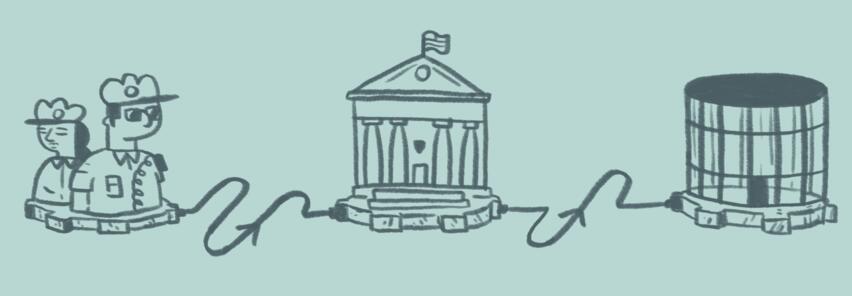Background on Criminal Courts
It might seem strange to illustrate criminal court like a machine. Criminal court is often glorified as a kind of hallowed and just institution, as if governed by laws untouched by human imperfection. We want to show it for what it is: dark and grimy place where prosecutors, judges, court officers and police officers work hard, every day, to criminalize and control other people, most acutely Black, Indigenous, disabled, migrant, poor, trans, and queer people.
In the United States, criminal law, criminal procedure and criminal courts are intertwined with the dispossession of Indigenous communities and the captivity of Black people into unfree labor. To this day, criminal law remains a critical tool for managing the crisis that is racial capitalism. As we go through each step in the path of the case, keep in mind the layers of oppression built into the laws, rules, processes, and procedures we’re often told are objective, neutral, and fair.
When we use the term criminal court, we refer to the legal institutions, processes, procedures, and actors that are involved in the progression of criminal cases. In criminal cases, the government, not the person who says they were harmed, is prosecuting individuals or institutions based on a possible violation of criminal law. If the prosecution is successful, the person accused is convicted and punished.
Criminal court involves both criminal law (what is a crime) and criminal procedure (the rules of criminal court), and each state defines its own law and procedures. That means that there are at least 52 distinct criminal legal systems in the United States (50 states and the District of Columbia, plus the federal criminal system). They are all supposed to follow the U.S. Constitution as interpreted by the Supreme Court. There are some differences across states, but here we’ve focused on the key general features that are shared across state-level systems in the United States. We won’t go into the federal system, but many of the steps of the path of a case are the same.
When we describe the path a case takes through the criminal punishment system, we’re mostly talking about how the rules of criminal procedure are applied.
Illusion:

Many people think the rules of criminal procedure are designed to make the process fair: to help guarantee that each side gets their chance to make their case, and that the outcome is determined in a way that is objective.
Reality:

At best, these rules give the appearance of fairness, but they don’t really deliver. The rules are rigged in favor of the prosecution and against the person accused of a crime. We’ll point out exactly how this happens as we go through each step of the case.
Throughout each step of a case, we'll present other common expectations versus what really happens. For example, we’re told that “justice” lies in the center of the criminal system. But at its core, the criminal court system is not about settling disputes or truth-telling. It is not a benign pathway from arrest to incarceration. The process itself can inflict serious harm, including on people seeking justice for harm done to them, and it exacerbates racial, economic, ableist and gender oppression, control, and exploitation. What it successfully achieves is surveilling, disciplining, and punishing people, without producing safety.


